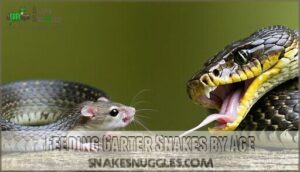This site is supported by our readers. We may earn a commission, at no cost to you, if you purchase through links.

Fish like tilapia or salmon work well, but avoid goldfish since they lack proper nutrition. Nightcrawlers and earthworms make excellent staples, while pinkie mice can supplement their diet.
Feed juveniles every 2-3 days and adults weekly. Always offer pre-killed prey that’s appropriately sized – about as wide as your snake’s thickest part.
Fresh water should always be available. Unlike ball pythons that stick to one prey type, garter snakes thrive on variety, making them surprisingly easy to keep satisfied. The secret lies in understanding their unique feeding patterns and nutritional requirements. Garter snakes are easy to keep satisfied because they thrive on varied diet and have unique feeding habits.
Table Of Contents
- Key Takeaways
- Garter Snake Diet Basics
- What to Feed Garter Snakes
- Foods to Avoid for Garter Snakes
- Supplements for Garter Snakes
- Feeding Garter Snakes by Age
- Feeding Problems in Garter Snakes
- How Much to Feed Your Garter Snake
- Creating a Balanced Diet for Garter Snakes
- Providing Fresh Water for G
- Frequently Asked Questions (FAQs)
- What do you feed a wild caught garter snake?
- What is a garter snake’s favorite food?
- Is it okay to keep a wild garter snake as a pet?
- What do garter snakes prefer to eat?
- How to make a garter snake habitat?
- Will a garter snake eat mealworms?
- How often should Garter snakes be fed?
- Can Garter snakes eat frozen food?
- Are gut-loaded insects suitable for Garter snakes?
- What signs indicate an overfed Garter snake?
- Conclusion
Key Takeaways
- You’ll want to feed your garter snake a varied diet including frozen-thawed mice (the gold standard), earthworms, nightcrawlers, and thiaminase-free fish like salmon or trout – avoid goldfish and human food scraps that can harm your pet.
- Feed juveniles every 2-3 days and adults weekly with prey that’s roughly as wide as your snake’s thickest body part, though overweight adults can stretch to every two weeks to maintain healthy weight.
- You’ll need to provide calcium supplements about once monthly if you’re feeding fish and worms instead of complete prey like mice, but avoid over-supplementation which can be just as harmful as deficiencies.
- Always keep fresh, dechlorinated water available in a shallow dish that’s about one-third your snake’s length – they’ll use it for drinking and soaking, especially during shedding periods.
Garter Snake Diet Basics
Your garter snake is a strict carnivore that needs meat-based meals to stay healthy and strong.
These reptiles can’t digest plants, so you’ll need to focus on providing the right animal proteins that match their natural hunting instincts.
Garter Snakes as Carnivores
Your garter snake is built to be a meat-eating machine. As obligate carnivores, these reptiles depend entirely on animal protein for survival.
Your garter snake is nature’s perfect predator, evolved over millions of years to hunt and consume only animal prey.
Their evolutionary adaptation over millions of years created perfect hunting tools:
- Specialized saliva that helps subdue prey with mild neurotoxins
- Sharp teeth designed to grip slippery fish and worms
- Efficient digestive system that processes only animal matter
Unlike omnivores, garter snakes can’t digest plants. Their nutritional needs center around protein and fat from prey animals, making the carnivore definition crystal clear in their feeding behavior.
Natural Prey in The Wild
In nature, your garter snake’s diet reads like a wild menu card.
They hunt amphibians like frogs and salamanders, snatch native rodents, and gobble up insects when available.
Regional variations mean coastal snakes favor fish while woodland species prefer earthworms.
Seasonal prey changes keep them adaptable – tadpoles in spring, adult frogs in summer.
This natural hunting behavior shapes what we should offer our captive friends.
What to Feed Garter Snakes
You’ll find several excellent food options for your garter snake, with frozen-thawed mice being the gold standard since they provide complete nutrition without supplements.
Fish fillets, earthworms, and nightcrawlers also work well, though these alternative foods may require calcium supplementation to keep your snake healthy.
Fish and Raw Meat Options
Looking beyond mice, frozen fish offers excellent variety for your garter snake’s diet.
Salmon and trout work perfectly since they’re thiaminase-free, unlike goldfish that cause vitamin B deficiency.
Raw meat like unseasoned chicken or turkey provides solid nutritional value too.
Focus on meat quality – fresh, unsalted options only.
Safe handling means thawing frozen items properly and keeping everything clean.
Remember, raw preparation requires supplements since fish for garter snakes alone won’t meet all dietary needs.
Live Prey Feeding
While frozen options work well, live prey can spark your garter snake’s natural hunting instincts and boost appetite.
Live feeders like small fish or earthworms offer excellent nutritional value when sourced properly. However, live prey ethics matter – choose reputable suppliers who handle animals humanely.
Watch for injury risks during feeding, as struggling prey might harm your snake. Parasite concerns also exist with wild-caught live food for garter snakes.
- Always supervise live feeding sessions to prevent accidents and remove uneaten prey within 30 minutes.
Consider your snake’s safety above all else when choosing live prey options.
Foods to Avoid for Garter Snakes
While garter snakes aren’t picky eaters in the wild, you’ll need to avoid certain foods that can harm your pet’s health or disrupt their digestive system.
Understanding which foods pose risks helps you make smart choices and keeps your snake healthy for years to come.
Human Foods and Leftovers
Never share your dinner plate with your garter snake, no matter how cute they look.
Skip the table scraps – your garter snake needs proper prey, not leftover pizza.
Human food dangers include processed foods, cooked meats, and dairy products that can poison them.
Grain consumption and vegetable matter aren’t part of a proper garter snake diet.
What garter snakes eat should only be their natural prey items for peak health.
Commercial Pet Foods
You might think prepared diets and commercial pet foods work for your garter snake, but they don’t.
Most food brands offer products with wrong nutritional balances. Pellet nutrition lacks variety your snake needs.
Cost analysis shows you’ll spend more fixing health problems later. Skip commercial options entirely.
Storage options for proper garter snake food like frozen mice are simpler and better for what garter snakes eat.
Wild Caught Prey and Potential Risks
While pet stores offer safe commercial options, you might consider wild-caught prey for your garter snake.
However, this path leads to serious risks that could harm your pet’s health and well-being.
Wild-caught prey creates dangerous situations for your snake:
- Parasite exposure from infected frogs and salamanders can cause internal damage
- Toxin ingestion from contaminated environments affects snake organ function
- Disease transmission through wild amphibians weakens your pet’s immune system
- Habitat contamination introduces harmful bacteria into your snake’s enclosure
These parasite risks and environmental toxins make wild-caught prey a poor choice for ethical sourcing.
Supplements for Garter Snakes
Your garter snake needs specific vitamins and minerals to stay healthy, especially if you’re feeding a varied diet of fish and worms instead of complete prey like mice.
You’ll want to add calcium powder to their food once a month to prevent bone problems and fill any nutritional gaps that might occur with alternative diets.
Vitamins and Minerals
Without proper vitamins and minerals, your garter snake faces serious health risks like vitamin deficiency and poor mineral absorption.
Essential nutrients include calcium, phosphorus, and B vitamins from natural sources or quality supplement brands. Think of it like a daily multivitamin for humans.
However, supplement overdosing can harm your pet just as much as deficiencies. Monitor calcium supplementation carefully and research reputable brands.
A balanced approach guarantees your snake gets necessary vitamins and minerals without dangerous excess.
Calcium and Phosphorus Supplements
Strong bones keep your garter snake healthy and active. Calcium supplementation works best when balanced with proper phosphorus ratios.
You’ll find quality calcium sources from trusted supplement brands, but watch for over-supplementation risks that can harm your pet. Many owners buy calcium supplements online for their snakes.
Here’s your supplement game plan:
- Choose supplements with vitamin D to boost calcium absorption
- Dust food lightly – correct supplement dosage prevents toxicity
- Monitor phosphorus levels to maintain the ideal 2:1 calcium ratio
- Rotate supplement brands to guarantee complete nutrition coverage
Balance beats excess every time.
Feeding Garter Snakes by Age
Your garter snake’s feeding schedule changes as it grows from a tiny hatchling to a full-sized adult.
Baby snakes need frequent meals every 2-3 days with small prey like pinky mice, while adults can go longer between feedings and handle larger food items, which is a significant change in their feeding schedule.
Baby Garter Snakes Feeding Schedule
Your baby garter snake’s feeding schedule requires careful attention to support rapid growth.
Feed hatchlings every other day with appropriately sized prey like defrosted pinky mice.
As they develop into juveniles, extend feeding frequency to every 4-5 days.
| Age Stage | Feeding Frequency | Recommended Food |
|---|---|---|
| Hatchling | Every 2 days | Pinky mice pieces |
| Juvenile | Every 4-5 days | Whole pinky mice |
| Young Adult | Weekly | Adult mice |
Monitor size progression and adjust portions accordingly for ideal development to ensure your snake receives the right amount of food, supporting its transition into a young adult and maintaining a healthy feeding schedule.
Adult Garter Snakes Feeding Schedule
As your snake matures, its feeding schedule shifts dramatically.
Adult garter snakes need meals every 7-14 days, depending on their size and season.
Here’s your complete feeding frequency guide:
- Prey size should match your snake’s thickest body section
- Weight monitoring helps prevent obesity in less active adults
- Seasonal adjustments mean reduced feeding during cooler months
- Brumation feeding may stop completely during winter dormancy
- Fresh water stays available year-round regardless of feeding amount
Feeding Problems in Garter Snakes
Even experienced snake owners can encounter feeding challenges with their garter snakes, from stubborn eaters who refuse meals to snakes that gain too much weight from overfeeding.
You’ll need to recognize these common problems early and adjust your feeding approach to keep your snake healthy and at the right body condition.
Overfeeding and Obesity
It’s easy to pile on too much food for your garter snake, leading to serious obesity problems.
Overfeeding creates a chubby appearance that signals health complications ahead. Your snake’s feeding schedule needs strict portion control to prevent weight gain.
Obesity indicators to watch for:
- Sluggish movement – Your snake moves slower and seems less active than usual
- Thick body segments – The snake’s body appears noticeably rounder between meals
- Difficulty shedding – Excess weight makes the natural shedding process more challenging
Monitor your garter snake diet carefully and provide adequate exercise needs through habitat enrichment.
Underfeeding and Malnutrition
Malnutrition creeps in when you don’t feed your garter snake enough.
Watch for weight loss, growth stunting, and prey rejection—clear warning signs.
Vitamin deficiencies and calcium deficiency can lead to organ failure if left unchecked.
| Signs of Underfeeding | Health Consequences | Prevention Tips |
|---|---|---|
| Weight loss | Organ failure | Regular feeding schedule |
| Growth stunting | Vitamin deficiencies | Varied prey items |
| Prey rejection | Nutritional imbalances | Monitor body condition |
| Poor shedding | Weakened immune system | Consistent portion sizes |
How Much to Feed Your Garter Snake
You’ll need to match your garter snake’s meal size to its body width, feeding prey that’s roughly as thick as the widest part of your snake’s body.
Young garter snakes eat every 2-3 days while adults only need food once a week, though overweight adults can stretch to every two weeks to maintain a healthy weight.
Determining Portion Sizes
Getting the prey item size right depends on your snake’s girth and age. A good rule of thumb: the prey should be as wide as your snake’s thickest part.
Here are key visual cues for proper portion sizes:
- Choose prey matching your snake’s mid-body width
- Juveniles need smaller prey than adults
- Watch for bulging after eating (sign of overfeeding)
- Underweight snakes need slightly larger prey
- Obesity risks increase with oversized portions
Frequency of Feeding
Three key factors determine your garter snake’s feeding schedule: age, season, and activity levels.
Adult garter snakes need meals every 7-14 days at ideal intervals, while juveniles require feeding every 4-5 days due to rapid growth stages.
During winter brumation effects, reduce feeding frequency as your snake’s metabolism slows markedly.
Seasonal variation affects appetite—snakes eat more in spring and summer when activity levels peak.
Monitor your pet’s body condition closely.
Overweight adults can stretch to two-week intervals, while underweight snakes need weekly meals.
Adjust your garter snake feeding schedule based on these natural patterns for healthiest results.
Creating a Balanced Diet for Garter Snakes
You’ll need to offer your garter snake different types of prey to meet all their nutritional needs, since no single food provides everything they require.
Creating this balanced approach means rotating between mice, fish, and worms while making sure any live prey you feed has been properly gut-loaded with nutritious foods.
Variety in Prey Items
Your garter snake’s nutritional needs shine when you offer Rodent Variety like mice and gerbils alongside Insect Options such as earthworms.
Fish Diversity adds excitement, but avoid thiaminase-rich species.
Skip Amphibian Risks from wild frogs due to parasites.
Scenting Prey with familiar foods helps picky eaters accept new garter snake food.
This food variety in prey items creates the balanced garter snake diet your pet deserves.
Gut Loading Prey Items
Boost your garter snake’s nutrition by gut loading prey items before feeding time. This process transforms ordinary insects into nutritional powerhouses for your pet’s health.
Here’s how gut loading enhances your snake’s diet:
- Feed insects fruits and vegetables 24 hours before offering them to your snake
- Load crickets with calcium-rich foods to strengthen your snake’s bones
- Supplement timing matters – fresh gut-loaded prey provides maximum benefits
- Variety in gutloaded insects guarantees complete nutritional needs are met
Enhanced benefits from proper gut loading methods make insect nutrition more valuable than standard prey variety alone. Consider using specialized products for insect nutrition.
Providing Fresh Water for G
Beyond creating a varied diet, fresh water forms the foundation of your garter snake’s health. Your snake’s water dish should be wide and shallow enough for complete body soaking, especially during shedding periods when shedding hydration becomes critical.
Choose a water dish size that’s roughly one-third your snake’s length. Water source safety matters—use dechlorinated or bottled water to avoid harmful chemicals. Water temperature should match room temperature, around 70-75°F.
Watch for hydration signs like clear eyes and smooth skin. Poor drinking habits or wrinkled skin signal dehydration. Snake water needs increase during shed cycles, so don’t skimp on bowl size.
Change water every 2-3 days or immediately after soiling. Clean bowls prevent bacterial growth that could harm your pet’s health.
Frequently Asked Questions (FAQs)
What do you feed a wild caught garter snake?
Don’t bite off more than you can chew with wild-caught snakes.
You’ll need frozen/thawed mice, earthworms, or fish fillets.
Feed juveniles every 2-3 days, adults weekly, and always provide fresh water.
What is a garter snake’s favorite food?
Your snake’s top choice is earthworms, especially nightcrawlers.
They’ll also enthusiastically devour frozen mice, which provide complete nutrition.
Fish and small rodents make excellent treats, but worms remain their absolute favorite meal.
Is it okay to keep a wild garter snake as a pet?
Like taking candy from a baby, catching wild garter snakes seems tempting, but you shouldn’t keep them as pets.
They carry diseases, need permits, and captive-bred snakes adapt better to home life.
What do garter snakes prefer to eat?
In captivity, your garter snake’s menu should center around frozen-thawed mice, which provide complete nutrition.
You can occasionally offer earthworms, nightcrawlers, or fish fillets for variety, but mice remain their dietary gold standard.
How to make a garter snake habitat?
Building the perfect snake mansion isn’t rocket science, but you’ll need a 40-gallon tank with secure lid.
You’ll also need temperature gradient (70-84°F), hiding spots, water dish, and substrates like aspen shavings for your slithery roommate’s comfort.
Will a garter snake eat mealworms?
Yes, you can feed your garter snake mealworms occasionally as part of a varied diet.
However, they’re not nutritionally complete like mice.
Use them as treats alongside earthworms, fish, and frozen rodents for peak health.
How often should Garter snakes be fed?
You should feed juvenile garter snakes every 2-3 days, while adults need feeding just once weekly. However, adult snakes can be fed every two weeks to prevent obesity.
Can Garter snakes eat frozen food?
Frozen-food feeding is fantastic for your garter snake’s health and safety.
You’ll find frozen/thawed mice are the gold standard, eliminating parasites and diseases.
Thaw completely before offering, making mealtime safer than live prey options, which is a fantastic approach for your garter snake.
Are gut-loaded insects suitable for Garter snakes?
Gut-loaded insects can supplement your garter snake’s diet occasionally.
They’re not complete nutrition like mice, but crickets and mealworms fed nutritious foods twenty-four hours beforehand provide decent variety for snakes already eating rodents.
What signs indicate an overfed Garter snake?
Adult garter snakes can become overweight if fed weekly instead of biweekly.
You’ll notice a visibly thicker body, reduced activity levels, difficulty moving, and sluggish behavior when your snake’s eating too much.
Conclusion
Feeding your garter snake properly isn’t complicated once you understand their needs.
By offering a varied diet of fish, earthworms, and occasional pinkie mice, you’ll keep your pet healthy and satisfied.
Remember to feed juveniles every 2-3 days and adults weekly with appropriately sized prey.
Fresh water should always be available, and understanding what to feed a garter snake guarantees your pet thrives with proper nutrition, making snake ownership rewarding and straightforward for any dedicated keeper.
- https://www.cbc.ca/news/canada/giant-garter-snake-nabbed-in-northern-manitoba-1.628299
- https://www.biologicaldiversity.org/species/reptiles/San_Francisco_garter_snake/index.html
- https://www.sciencedirect.com/science/article/pii/S1094919417301391
- http://www.gartersnake.co.uk/maintenance.htm
- https://www.nps.gov/articles/000/common-garter-snake.htm
















